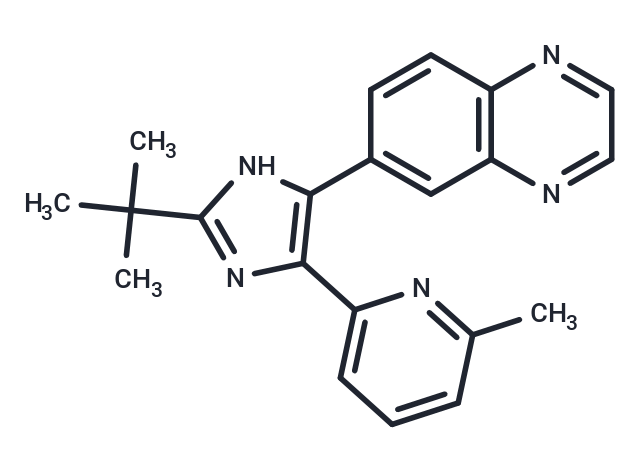Shopping Cart
- Remove All
 Your shopping cart is currently empty
Your shopping cart is currently empty

SB-525334 is a potent and selective inhibitor of the TGF-β1R and ALK5 (IC50: 14.3 nM).

| Pack Size | Price | Availability | Quantity |
|---|---|---|---|
| 5 mg | $32 | In Stock | |
| 10 mg | $53 | In Stock | |
| 25 mg | $107 | In Stock | |
| 50 mg | $179 | In Stock | |
| 100 mg | $283 | In Stock | |
| 200 mg | $335 | In Stock |
| Description | SB-525334 is a potent and selective inhibitor of the TGF-β1R and ALK5 (IC50: 14.3 nM). |
| Targets&IC50 | ALK4:58.5 nM, ALK5:14.3 nM (cell free) |
| In vitro | SB-525334 (1 μM) blocked TGF-beta1-induced phosphorylation and nuclear translocation of Smad2/3 in renal proximal tubule cells and inhibited TGF-beta1-induced increases in plasminogen activator inhibitor-1 (PAI-1) and procollagen alpha1(I) mRNA expression in A498 renal epithelial carcinoma cells [1]. The combination with SB525334 significantly augmented the cytotoxicity of gemcitabine in both parental and gemcitabine-resistant pancreatic cancer cells. SB525334 significantly increased apoptotic cell death in gemcitabine-resistant cells [2]. |
| In vivo | Orally administered doses of 1, 3, or 10 mg/kg/day SB-525334 for 11 days produced statistically significant reductions in renal PAI-1 mRNA [1]. SB-525334 (10 mg/kg or 30 mg/kg) was orally administered at twice a day. Lungs were isolated 5, 7, 9 and 14 days after Bleomycin (BLM) treatment. BLM treatment led to significant pulmonary fibrotic changes accompanied by significant upregulation of ECM mRNA expressions, Smad2/3 nuclear translocation, CTGF expression, myofibroblast proliferation and type I collagen deposition. SB-525334 treatment attenuated the histopathological alterations in the lung, and significantly decreased the type I and III procollagen and fibronectin mRNA expression [3]. |
| Kinase Assay | To determine the potency of the ALK5 inhibitor SB-525334 at the enzyme level, purified GST-tagged kinase domain of ALK5 was incubated with purified GST-tagged full-length Smad3 in the presence of 33P-γATP and different concentrations of SB525334. The readout is radioactively labeled Smad3. To determine the selectivity of SB-525334, purified GST-tagged kinase domain of ALK2 and ALK4 were incubated with GST-tagged full-length Smad1 and Smad3, respectively, in the presence of different concentrations of SB-525334 (n=3). IC50 value determinations were calculated with GraphPad software using a sigmoidal dose-response curve [1]. |
| Cell Research | RPTE cells were seeded on microscope slides. The following day, the cells were starved by removal of epidermal growth factor and serum for 24 h prior to dosing. Cells were dosed with 10 ng/ml TGF- 1 or 1 M SB-525334 or a combination of both. Slides were pretreated with SB-525334 or starve media for 3 h prior to a 1-h incubation at 37°C with TGF- 1 or starve media. The cells were then fixed for 15 min in 4% ice-cold paraformaldehyde. The cells were permeabilized for 10 min in 0.3% Triton X-100/PBS at room temperature. The slides were incubated for 30 min in a blocking solution containing 0.3% bovine serum albumin, 10% FBS, 0.3% Triton X-100/PBS, and 5% milk in PBS. A 1:200 dilution of primary mouse anti-Smad2/3 antibody was applied to each slide for overnight incubation. A 1:200 dilution of anti-mouse IgG fluorescein secondary antibody was applied to each slide for 30 min at room temperature. The slides were then viewed using an argon blue 488 nM laser in a confocal microscope. Nuclear signal intensity was analyzed using 1D Image Analysis software. The relative intensity was determined by the mean intensity of the nucleus and expressed as percent control [1]. |
| Animal Research | To identify the optimal treatment length for puromycin aminonucleoside's effect on extracellular matrix in the kidney, 18 Sprague-Dawley (SD) rats (200 –250 g) were injected with 15 mg/100 g of puromycin aminonucleoside in 0.9% saline or sham 0.9% saline only intraperitoneally. Animals were sacrificed at 24 h (n = 3+2 control), day 4 (n=3), day 8 (n = 3), day 10 (n = 3), day 15 (n = 2), and day 20 (n = 2). A 24-h urine collection and plasma sample were taken at 9:00 AM everyday. Urine and plasma chemistry were measured at GlaxoSmithKline Laboratories Animal Science using an Olympus clinical analyzer. Proteinuria was measured as a concentration (mg/deciliter) and then converted to total protein excreted over a 24-h period using urine flow (mL/24 h). The creatinine clearance was calculated by multiplying urine creatinine levels (mg/mL) by urine flow (mg/mL/100 g b.wt.) and then dividing that product by plasma creatinine (mg/mL). To determine the effect of SB-525334 on renal disease in the PAN model, SD rats were pretreated by oral gavage with 1, 3, or 10 mg/kg/day of SB-525334 once a day. The following day, PAN was injected at 15 mg/100 g to the appropriate rats. Treatment groups continued to receive SB-525334. Ten days after PAN injection the rats were sacrificed, and blood, urine, and kidneys were collected at the termination point for analysis [1]. |
| Alias | SB525334 |
| Molecular Weight | 343.42 |
| Formula | C21H21N5 |
| Cas No. | 356559-20-1 |
| Smiles | C(C)(C)(C)C=1NC(=C(N1)C=2N=C(C)C=CC2)C3=CC4=C(C=C3)N=CC=N4 |
| Relative Density. | 1.191 g/cm3 |
| Storage | Powder: -20°C for 3 years | In solvent: -80°C for 1 year | Shipping with blue ice. | |||||||||||||||||||||||||||||||||||
| Solubility Information | H2O: < 1 mg/mL (insoluble) DMSO: 50 mg/mL (145.59 mM), Sonication is recommended Ethanol: 50 mg/mL (145.59 mM), Sonication is recommended | |||||||||||||||||||||||||||||||||||
Solution Preparation Table | ||||||||||||||||||||||||||||||||||||
DMSO/Ethanol
| ||||||||||||||||||||||||||||||||||||

Copyright © 2015-2025 TargetMol Chemicals Inc. All Rights Reserved.